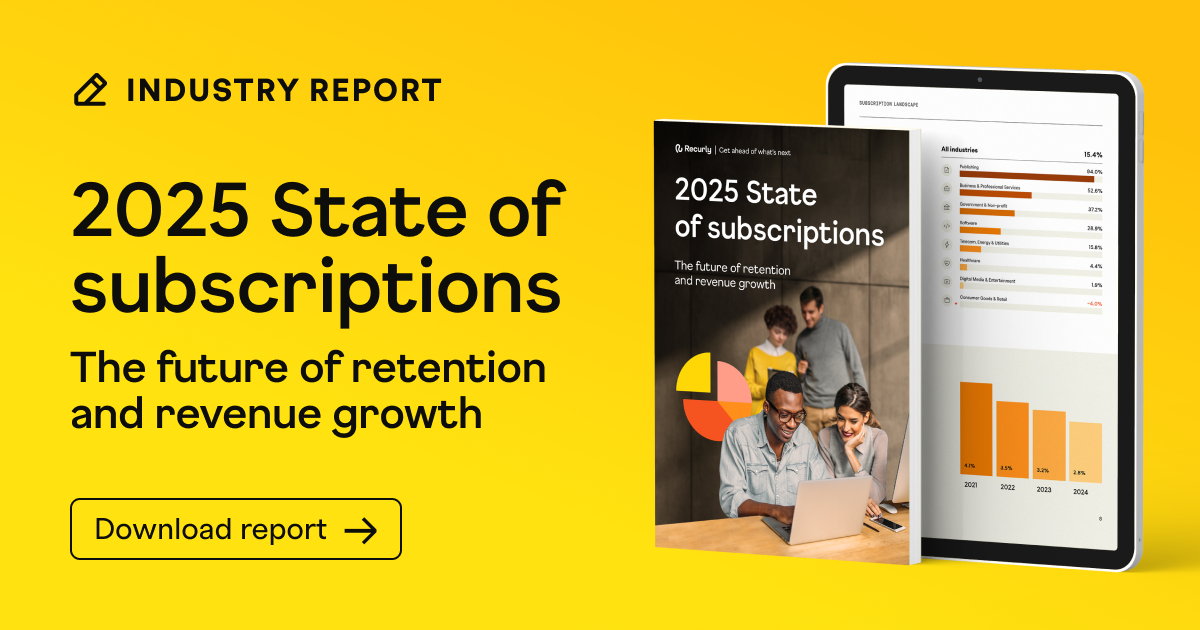The role of customer retention management in subscription success

Reporting shows that customer acquisition costs have risen over 222% in the past ten years, while acquisition rates have dropped from 4.1% in 2021 to just 2.8% in 2024. These trends underscore a hard truth for subscription businesses in particular: growth is no longer about just acquiring new customers, but retaining the ones you already have.
Customer retention management is key to growing a successful subscription business to new levels. In this article, we’ll explore what customer retention means, why it’s crucial for subscription models, and how effective strategies can boost profits and ensure long-term success. Retaining customers is the foundation of a thriving business.
What is customer retention management?
Customer retention management is the process of keeping existing customers engaged and satisfied with your product or service to build long-term loyalty and reduce churn. This is done in various ways, such as exclusive products, loyalty programs, payment flexibility, plan options, and more.
Unlike one-time purchases, subscriptions depend entirely on maintaining customer relationships over time, making retention the lifeblood of your business.
Core principles of customer retention include:
Understanding customer needs through data and behavior patterns
Delivering consistent value via products, personalization, and innovation
Fostering loyalty with flexible, customer-centric strategies
When businesses fail to prioritize retention, they risk missed revenue opportunities and steep declines in customer lifetime value (CLV).
The unique challenges of subscription retention
Subscription businesses face distinct retention challenges compared to one-time purchase models. Each new month brings an opportunity for customers to cancel their subscriptions, making customer satisfaction crucial for the survival of subscription-based businesses. Some challenges that affect this are:
Lack of perceived value: If customers don’t see consistent value in what they’re paying for, they are more likely to cancel the service. With the click-to-cancel ruling, this will only get easier for subscribers to do. Subscription businesses must constantly communicate and deliver the benefits of their offerings.
Poor customer experience: Complicated billing, unclear cancellation policies, or poor customer support can frustrate users and lead them to leave. A confusing customer experience leads to churn. 96% of customers are willing to leave a service after one bad service experience.
Price sensitivity: Consumers are starting to pay over $1000 a year for subscriptions according to recent reports. Concerns over rising subscription costs can make customers churn, unless businesses demonstrate why the value outweighs the price hike.
Competition: Competition among subscription-based platforms is fierce with many different options across different sectors. Pair this with rising subscription fatigue, and it’s becoming harder for subscription platforms to keep subscribers.
Payment failures: These "silent churners" result from expired cards or insufficient funds. Alarmingly, nearly 65% of surveyed businesses report that failed payments negatively impact customer lifetime value.
To tackle these challenges, businesses need to understand the difference between proactive retention (preventing churn by engaging customers and maintaining value) versus reactive retention (winning them back after the relationship starts to fray).
The benefits of customer retention management
Customer retention management generates a host of measurable benefits:
1. Increased revenue and profitability
Lower churn rates means more predictable recurring revenue for platforms. Long-term customers drive higher CLV, are more receptive to upgrades, and are more likely to engage with one-off products and additional offerings. Strong retention builds stable, recurring income that can buffer against unpredictable acquisition performance.2
2. Reduced acquisition costs
Gaining new subscribers can cost 5-25x times more than retaining existing customers. Retention strategies mean spending less on marketing and outreach, freeing up resources for improving your offerings. Retention strategies also simplify the process for subscribers to return to a service. In fact, 20% of all acquisitions stem from consumers resubscribing to a service.
3. Enhanced brand loyalty and customer insights
Happy subscribers turn into brand advocates, spreading positive word-of-mouth. Retention strategies also provide invaluable data about subscriber preferences, behaviors, and purchasing trends, which you can use to inform future growth initiatives. If you’d like to learn more about subscriber behavior, check out our study of what consumers want.
Winning subscriber retention strategies
Improving user experience, fostering strong communities, and strengthening your customer support experience are key long-term strategies to boost retention. For a deep dive, check out our guide on customer retention strategies. In the meantime, here are some concrete subscriber retention tactics you can start implementing now.
1. Flexible billing and payment plans
Subscribers value flexibility when it comes to billing, payments, and plan options. Recurly reported a 68% year-over-year increase in paused subscriptions, with over 51% of customers retained because of this feature.
Subscribers should be able to easily upgrade, downgrade, or pause their plans
Personalized renewal offers such as ad-supported plans, discounts, bundles, and even pausing plans for specific periods
Subscribers are increasingly opting for alternative payment methods like Apple Pay and Google Pay — and merchants should offer these options
2. Personalized experiences
Personalization goes far beyond simply adding "Hi, [fname]" to an email. It’s about tailoring your product to meet the unique needs of your subscribers. Personalization spans products, offerings, and plans, and with the right tools, you can engage subscribers throughout the entire lifecycle. Tactics for personalization include:
Deliver personalized content or product recommendations based on user behavior
Offer products, support, and services tailored to the language of the region
Explore cross-selling complementary items or creating value-added bundles
Consider allowing customers to design their own plans around your products
Offer multiple tiers, price points, add-ons, and subscription options to match customer needs
3. Data-driven insights
Understanding your subscribers is key to mastering retention. Metrics like churn rate, LTV, and retention rate are essential for evaluating the effectiveness of your strategy. These insights show how your subscribers are doing and help build long-term loyalty. Use data to spot patterns in behavior, personalize your approach, and retain more customers.
Tools like Recurly’s analytics and Recurly Compass AI can help you make informed decisions to scale and grow quickly. Re-engage lost customers and drive acquisition. Recurly Compass AI specifically helps surface the most important analytics and shifts in your platform. A suite of AI tools to help you get personalized insights, playbooks to help you chart your path, and answers you need to succeed.
4. Retrying failed transactions
Failed payments are one of the most preventable causes of involuntary churn — yet many subscription businesses still treat them as inevitable losses. The truth is, these accounts don’t have to be lost. With the right tools, you can take a proactive approach to failed payments. Modern retry systems now go beyond basic rules or fixed schedules. Some tools, like Recurly’s Intelligent Retry system, use machine learning to analyze payment patterns and determine the best times to retry transactions. By factoring in variables like decline type, payment gateways, and historical success rates, these systems give each payment a better chance of success.
💡Pro tip: Don’t underestimate clear communication. Regularly educate your customers on how to maximize the value of their subscription. Whether through email updates, webinars, or in-app notifications, empowering users often leads to longer retention. For best results, communicate directly in the customer’s native language.
Leverage a subscription management system for retention
Retention-focused businesses need the right tools. A subscription management platform, like Recurly, can simplify the complexities of customer retention management systems and help you build long-term subscriber loyalty.
Key Recurly features that drive retention:
Automated payment retries to reduce involuntary churn from failed payments
Flexible subscription plans with upgrades, downgrades, and pauses
Detailed customer retention analytics to track engagement, churn, and much more
Real-time subscriber insights to enable personalized outreach and reactivation campaigns
Your retention journey starts here
Growth isn’t about acquisition anymore. It’s about retention. Subscription businesses must shift their focus to proactively holding onto the customers they already have, delivering value, and building long-term loyalty.
Want to learn more about retention? Check out our State of Subscriptions report for all the latest retention trends or book a demo with Recurly to see how we can help you unlock sustainable growth and drive subscriber success.
Your subscribers deserve the best, and so does your business.


